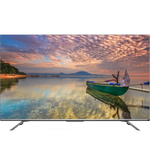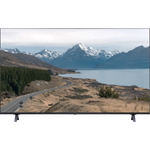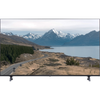A comparison of specs, key information, reviews, and best pricing from top retailers
Last updated -- hours ago | Report incorrect information
What we think

The PerfectRec TV team Learn more
Updated January 10, 2024·
The Hisense U7H tends to be a bit more expensive than the LG UP8000, but it offers superior overall picture quality, making it a better choice for movies and gaming, particularly with its 120Hz screen and support for various high dynamic range formats like HDR10+ and Dolby Vision. It also performs decently in bright rooms. On the other hand, the LG UP8000 is less expensive and has good wide viewing angles, making it a better fit for watching sports or content with multiple viewers spread out across the room. It’s more suited to environments without a lot of light, as its performance in bright rooms is not as strong as the Hisense. Give Feedback
this description is based on the product variant with some specs and product variant with some specs. At the time of writing, the variant with some specs cost some dollars and the variant with some specs cost some dollars.
Advantages of the Hisense U7H (LCD)
- Good for bright room
- Good for dark room
- Good for gaming
- Good for movies & TV
- Very good for news, talk, & other TV
- Good for cartoons & animation
Advantages of the LG UP8000 (LCD)
- Good viewing angle
- Good reflections
Key differences
Picture Quality
7.6


5.7
7.50/10
CONTRAST
5.10/10
8.3/10
COLOR VOLUME SCORE
5.8/10
LED FALD
PANEL TYPE
LED
VA
PANEL SUB-TYPE
IPS
The Hisense U7H (LCD) has good picture quality, while the LG UP8000 (LCD) has poor picture quality.
Movies & TV
7.4


5.3
7.50/10
CONTRAST
5.10/10
5.7/10
BLACK UNIFORMITY
5.5/10
7.5/10
UPSCALING
7.5/10
Yes
HDR10 SUPPORT
Yes
Yes
HDR10+ SUPPORT
No
Yes
DOLBY VISION SUPPORT
No
The Hisense U7H (LCD) is good for movies & TV, while the LG UP8000 (LCD) is poor.
The Hisense U7H excels in watching movies and cinematic TV largely due to its high contrast ratio, effective local dimming, and good black uniformity, which result in deeper blacks and more detailed dark scenes. On the other hand, the LG UP8000 falls short because it lacks local dimming and has a lower contrast ratio and black uniformity, leading to less impressive dark scene performance.
Sports
6.0


6.6
3.2/10
MOTION PROCESSING
6.0/10
120Hz
REFRESH RATE
60Hz
7.6/10
INPUT LAG SCORE
10.0/10
7.5/10
UPSCALING
7.5/10
8.7/10
SDR BRIGHTNESS SCORE
6.5/10
Yes
HLG SUPPORT
Yes
The LG UP8000 (LCD) and Hisense U7H (LCD) are both only fair for sports, though the LG UP8000 (LCD) is somewhat better.
The Hisense U7H has a lower response time compared to the LG UP8000, leading to less blur in fast-moving scenes, essential for sports viewing. However, the Hisense U7H is less capable in handling reflections and has narrower viewing angles than the LG UP8000, which could be an issue in bright rooms or for viewers sitting off to the side.
Gaming
7.7


5.7
5.8/10
RESPONSE TIME SCORE
6.7/10
7.6/10
INPUT LAG SCORE
10.0/10
3.2/10
MOTION PROCESSING
6.0/10
75.0/100
GAMING LOCAL DIMMING
0.0/100
8.0/10
GAME HDR BRIGHTNESS SCORE
6.0/10
The Hisense U7H (LCD) is good for gaming, while the LG UP8000 (LCD) is poor.
The Hisense U7H is better for gaming as it features a faster response time and lower input lag, providing smoother gameplay, whereas the LG UP8000, despite having extremely low input lag, offers a slower response time, which can be less optimal for fast-paced gaming. Additionally, the Hisense U7H supports a higher refresh rate, enhancing game fluidity and responsiveness compared to the LG UP8000's lower refresh rate.
Cartoons & Animation
7.9


5.9
7.7/10
COLOR GAMUT SCORE
5.9/10
8.3/10
COLOR VOLUME SCORE
5.8/10
8.7/10
SDR BRIGHTNESS SCORE
6.5/10
6.5/10
COLORS OUT OF THE BOX SCORE
7.1/10
7.0/10
GRAY UNIFORMITY
6.2/10
The Hisense U7H (LCD) is good for cartoons & animation, while the LG UP8000 (LCD) is poor.
News, Talk, & Other TV
8.1


6.2
8.7/10
SDR BRIGHTNESS SCORE
6.5/10
7.5/10
UPSCALING
7.5/10
The Hisense U7H (LCD) is very good for news, talk, & other TV, while the LG UP8000 (LCD) is only fair.
The Hisense U7H offers very good SDR brightness and local dimming which contributes to a better contrast, making it very good for watching news and talk shows, while the LG UP8000, with fair SDR brightness and lack of local dimming, delivers only fair performance for the same content.
Bright Room
7.7


5.9
5.4/10
VIEWING ANGLE
7.5/10
8.7/10
SDR BRIGHTNESS SCORE
6.5/10
7.5/10
HDR BRIGHTNESS SCORE
5.8/10
6.6/10
REFLECTIONS SCORE
7.0/10
The Hisense U7H (LCD) is good for bright room, while the LG UP8000 (LCD) is poor.
The Hisense U7H has superior brightness in both standard and high dynamic range content, which means it can better maintain picture quality in a bright room compared to the LG UP8000, which has lower brightness and may appear dimmer under the same conditions. Additionally, while the Hisense U7H handles reflections adequately, the LG UP8000 is slightly better at minimizing reflections, but its overall lower brightness makes it less suitable for watching in well-lit environments.
Cost
$698


$830
$200
$400
$600
$800
$1,000
$1,200
$1,400
The Hisense U7H (LCD) has a price of $698 and the LG UP8000 (LCD) costs $830.

Let Us Help Find Your Perfect TV
Find your new TV
Give feedback
We’re constantly working to improve.
How the Hisense U7H (LCD) and the LG UP8000 (LCD) compare to other TVs
Spec Comparison
| Hisense U7H (LCD) | LG UP8000 (LCD) |
GENERAL | |||
|---|---|---|---|
| Price | |||
$698 | $830 | ||
Brand | |||
Brand | Hisense | LG | |
Release Date | |||
Release Date | August 2, 2022 | July 5, 2021 | |
Full name | |||
Full name | 65U7H | 65UP8000 | |
Screen Size | |||
Screen Size | 65" | 65" | |
Screen Resolution | |||
Screen Resolution | 4K | 4K | |
TV FEATURES | |||
|---|---|---|---|
Operating System | |||
Operating System | Google TV | webOS | |
Sound Quality Score | |||
Sound Quality Score | 7.5/10 | 6.7/10 | |
NextGen Ready | |||
NextGen Ready | Yes | No | |
HDMI Ports | |||
HDMI Ports | 4 | 3 | |
Coax Ports | |||
Coax Ports | 1 | 1 | |
DISPLAY QUALITY SCORES | |||
|---|---|---|---|
Picture Quality Score | |||
Picture Quality Score | 7.6/10 | 5.8/10 | |
Bright Room Score | |||
Bright Room Score | 7.7/10 | 6/10 | |
Gaming Score | |||
Gaming Score | 7.7/10 | 5.8/10 | |
Movies & TV Score | |||
Movies & TV Score | 7.4/10 | 5.4/10 | |
Sports Score | |||
Sports Score | 6.1/10 | 6.6/10 | |
PHYSICAL | |||
|---|---|---|---|
Dimensions w/o Stand (H x W x D) | |||
Dimensions w/o Stand (H x W x D) | 33.1" x 57" x 3.5" | 33" x 57.2" x 2.3" | |
Dimensions with Stand (H x W) | |||
Dimensions with Stand (H x W) | 35.5" x 57" | 35.4" x 57.2" | |
Weight without Stand | |||
Weight without Stand | 43.0 lbs | 47.4 lbs | |
VESA Mount | |||
VESA Mount | 300 x 200 | 300 x 300 | |
DISPLAY | |||
|---|---|---|---|
Color Depth | |||
Color Depth | 10 bit | 10 bit | |
Black Frame Insertion | |||
Black Frame Insertion | Yes | No | |
Auto Low Latency Mode | |||
Auto Low Latency Mode | Yes | Yes | |
Contrast | |||
Contrast | 7.5/10 | 5.1/10 | |
Local Dimming | |||
Local Dimming | 7/10 | 2.5/10 | |
SOUND | |||
|---|---|---|---|
Speaker Setup | |||
Speaker Setup | 2.0 | 2.0 | |
Speaker Power | |||
Speaker Power | 20 W | 20 W | |
Dolby Atmos | |||
Dolby Atmos | Yes | Yes | |
DTS:X | |||
DTS:X | Yes, Bypass only | No | |
Shopping
Hisense U7H (LCD)
See more
Dig into reviews and images
Tom's guide
Christian de Looper | December 2022
"We loved the Hisense U7H. It was able to deliver an excellent all-around image quality in its price range. The TV excels at controlling its backlighting in a way that ensures you’ll never experience blooming to a level of being distracting, something that I was a little surprised to see given the lack of Mini LED. The TV doesn’t just get decently bright it offers relatively accurate color reproduction for a TV in this price range. The TV is being billed excellent for gaming."
LG UP8000 (LCD)
See more
Dig into reviews and images
Home Media Entertainment
Stratos Kampourogiannis | July 2021
"What we liked on this one was the very sharp 4K images it could display, its good up-scaling capabilities, nice viewing angles and extremely low input lag. Lastly the new webOS 6.0 is great even if it needs some time to get your bearings while the redesigned Magic Remote feels fresh even if functionality remains the same."
Get a great deal on the Hisense U7H (LCD) or the LG UP8000 (LCD)
About Hisense
Hisense, a Chinese TV manufacturer, entered the US market in approximately 2011 and has since acquired TV divisions from various companies such as Toshiba, Sharp, Hitachi, and NEC. Currently ranking as the fourth largest vendor in terms of sales volume, Hisense aims to capture a wide range of TV budget segments. They offer exceptional value with TVs that often outperform their competitors at similar price points, making them a compelling choice for consumers. In the US, they use Google TV as their smart TV software which provides the largest app selection and a very modern user interface, however it is not as user friendly as the software from other vendors.
About LG
LG, a prominent TV brand from Korea, has played a significant role in popularizing OLED TVs. OLED technology is hailed as the future of TV technology. Their TVs employ WebOS, a proprietary smart TV software that not only offers seamless functionality but also includes gaming-specific features, earning praise from players worldwide. Often regarded as the gateway to unparalleled viewing experiences, LG's mid-range OLEDs come highly recommended, making them a worthwhile investment for those willing to stretch their budget for superior quality.
Give feedback
We're constantly perfecting our model
TV guides you might be interested in
More comparisons for you
FAQs
FAQs about TVs
Why trust us
This information was produced and vetted by the PerfectRec TVs team. We are a product research and recommendation organization that meticulously reviews and evaluates the latest TV information and makes it digestible for you.
By the numbers
385
TVs evaluated
33,110
TVs stats compiled
21
Proprietary TVs ratings developed
179,430
Recommendations made
26,915
Consumer hours saved
About the TV team
Joe Golden, Ph.D
CEO and TVs Editor
Joe is an entrepreneur and lifelong electronics enthusiast with a Ph.D in Economics from the University of Michigan.
Jason Lew
Staff Expert & Software Engineer
Jason is a staff expert and software engineer that has been making laptop recommendations for 7 years and moderates one of the largest laptop subreddits.
Chandradeep Chowdhury
Staff Expert & Software Engineer
Chandradeep is a staff expert and software engineer and expert in televisions and monitors. He’s been making monitor recommendations for ten years.
Jaime Roldán
TVs Expert
Jaime is a Colombia-based TV expert. He is an electronics engineer with 8 years of experience in the telecom sector and has been making TV recommendations for 12 years.







